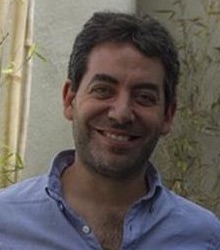Save the date 20-22 April 2018

Speaker Details
|
|
|
|
Biography |
|
|
 Adrián Turjanski obtained his Master degree in Chemistry from the University of Buenos Aires in Argentina in 1999, and then his PhD in Biophysics in 2003. He conducted postdoctoral studies in the area of molecular modeling from 2003 to 2005 in the Department of Physiology and Molecular Biology, School of Sciences, University of Buenos Aires. He then conducted postdoctoral work in Bioinformatics as a 2005 Pew Latin American Fellow in the National Institute of Dental and Craniofacial Research at the National Institutes of Health. Bethesda, MD,USA. In 2008 he returned to Argentina where he is in charge of the Structural Bioinformatics Lab, in the school of sciences at the University of Buenos Aires. He is part of the research staff of the National Research and Technology Council (CONICET). He has also been Full Professor of Bioinformatics at the University of Buenos Aires since 2008. In 2013 he became director of the Argentinian Bioinformatic Platform and in 2015 his the Director of the Center for Interdisciplinary Sciences at the School of Sciences. His research is focused in the developing and application of Bioinformatics tools for drug discovery, going from the genome to structural characterizations of proteins.
Adrián Turjanski obtained his Master degree in Chemistry from the University of Buenos Aires in Argentina in 1999, and then his PhD in Biophysics in 2003. He conducted postdoctoral studies in the area of molecular modeling from 2003 to 2005 in the Department of Physiology and Molecular Biology, School of Sciences, University of Buenos Aires. He then conducted postdoctoral work in Bioinformatics as a 2005 Pew Latin American Fellow in the National Institute of Dental and Craniofacial Research at the National Institutes of Health. Bethesda, MD,USA. In 2008 he returned to Argentina where he is in charge of the Structural Bioinformatics Lab, in the school of sciences at the University of Buenos Aires. He is part of the research staff of the National Research and Technology Council (CONICET). He has also been Full Professor of Bioinformatics at the University of Buenos Aires since 2008. In 2013 he became director of the Argentinian Bioinformatic Platform and in 2015 his the Director of the Center for Interdisciplinary Sciences at the School of Sciences. His research is focused in the developing and application of Bioinformatics tools for drug discovery, going from the genome to structural characterizations of proteins.
|
|
|
|
|
|
|
Abstract |
|
|
|
|
Bioinformatics for drug discovery in pathogens |
|
|
|
|
|
Available genomic data for pathogens has created new opportunities for target identification and drug discovery, including new species, resistant and multiresistant ones. However, this data must be cohesively integrated to be fully exploited and be easy to interrogate. I will present the work we have done in developing tools that include genomic annotation, structural prediction, metabolic pathways determination and target prioritization algorithms.
I will discuss the development of TARGET PATHOGENS, which allows genome wide based data consolidation from diverse sources at different processing stages focusing on structural analysis of proteins and the prediction of druggability for potential targets and compound desirability information. By allowing the integration and weighting of this information, this bioinformatic tool aims to facilitate the identification and prioritization of candidate drug targets for pathogens. I will finally discuss it application to Mycobacterium Tuberculosis and the identification of a lead compound using novel simulations tools developed at our lab. |
|
|
|
|